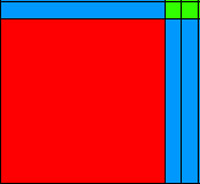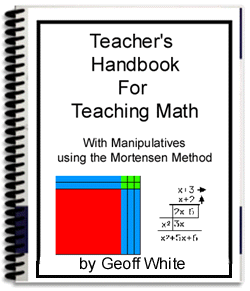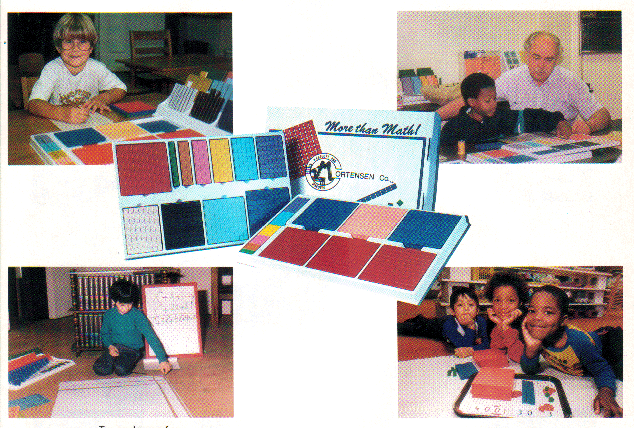
7 Reasons Why Kids Deserve Mortensen Math
by Geoff White, B.Ed. (Southampton, UK)
I am often asked how to differentiate Mortensen Math (MM) from traditional ways of teaching.
I say that I cannot do this in 5 minutes, but give me an hour of your time and I may succeed in opening a whole new world to you. To begin with, there is not one thing alone that MM does differently. Like Euclid, the system employs several axioms that inter-act simultaneously to enable a richer understanding of mathematics even to young minds.
Math Made Visual
Firstly, MM makes math visual, but it is not merely the addition of pretty illustrations as you see in Houghton-Mifflin and Scott-Foresman textbooks, or in the Singapore method. In MM the student is asked to visualize all numbers as rectangles.
Counting is King
Secondly, it requires full commitment to the axiom that all we do in math is count. All the operations are just counting.
Behold, the Rectangle!
Thirdly we employ a rectangular model. It sounds innocuous but it turns all math teaching to date on its head and opens the door to rapid comprehension of math concepts by clearing away all the irrelevant clutter. It enables us to see the forest in spite of the trees.
We build rectangles to facilitate rapid, accurate counting.
Bad Algorithms!
Fourthly, because of these things the relationships between the quantities in the example are obvious and readily available to the child. Using traditional methods of pushing symbols around in memorized ways employing algorithms, instead of teaching for understanding, actually obscures the relationships and prevents understanding!
Here is where I get excited and allow my consternation to show. I want, as every parent should want, the system to stop damaging children's lives by continuing to teach anything requiring drill and memorization. The least effect this has on them is to damage their motivation to continue with the study of math, destroying their chances of future employment in exciting STEM careers (Science, Technology, Engineering, Mathematics.)
These are strong claims. Now, I must back them up.
By far the largest part of the brain devoted to taking in information is in the visual cortex. Every textbook in all other subjects has lots of pictures. Not so with math. Open a grade five math textbook and you will see nary a picture. Sure, they try to make it colourful and use pictures in the lower grades. Some of the texts are beautifully produced, but none of it has anything to do with math. Inserting pictures of daisies or sheep is meaningless. That is not six you have there, it is a picture of half a dozen sheep - nothing to do with math and in no way helpful to learning number, or counting, which is supposed to be the point of the book.
I offer an alternative. Cue the upbeat music.
MM makes math visual by showing all numbers as rectangles. The axiom is:
1) see all numbers as rectangles, then
2) All we do in math is count
3) To count we must know what one is. We must define the unit. It is a rectangle "one over and one up."
Instantly, we necessarily involve the other axioms, as above. To make it visual you need a model: the rectangle. You must see all numbers as rectangles where one is a rectangle (square) one unit on a side. Now, all numbers are rectangles so many over and so many up. This instantly reveals relationships between the factors of the numbers. No instruction is necessary, simple sensory experience is all that is needed.
Hands-On learning is a Must
Fifthly, MM uses manipulatives, providing the necessary tactile-motor-kinaesthetic experiences a child needs in order to develop fully-fleshed out pre-concepts, leading to concepts through assimilation and accommodation of these experiences, to forming concepts and thus achieving understanding. This last stage can occur in such a rush as it all comes together that the Aha! moments are plentiful, even in adults. Smiles result, joy in learning is experienced. Success is achieved. These memories will stand in place of the frustration, doubt, anxiety, and loathing that people often experience when subjected to traditional math teaching based on memorization of facts, rules, formula and process.
Show the Big Picture
Sixth, MM exposes the child to math holistically, she gets to see all the program, including calculus and algebra from a very young age, ten years or more before she would see it in a traditional math program. The assumption has been that a very young child should only be shown little numbers because they are little. If we taught language this way a child would only hear little words for the first five years of her life: it, and, was, to, for, she, he, dog, cat.
It would be 7 or 8 years before she heard a three syllable word such as umbrella or waterbed or radio. She would be a teen ager before she knew the name of the television or hear a complex sentence, such as, "Eat your vegetables, or you won't get dessert." or "If you don't clean your room, you will not be allowed to go see your friends." Real life has shown that logically complex ideas can be grasped quite readily by very young children, and so it is with mathematics. Jerry Mortensen has said there is no mathematical concept a child cannot learn if it is presented at the child's level. The reasons why algebra and calculus teaching has failed is because it has been presented abstractly instead of being made visual, with hands-on experiences, and using a rectangular model.
MM gives the child experience of algebra and kindergarten calculus by the use of manipulatives employing the rectangular model and making it visual, rather than by drilling rules to be memorized for manipulating meaningless symbols, actually denying children understanding by obscuring the true relationships between numbers and their factors, thus frustrating them, denying them success and joy and setting back their learning years, possibly preventing them from ever pursuing math at a higher level.
Educate the Whole Child
Seventh, a child-centred approach to education means giving the child what she needs, when she needs it and how she needs it, in other words, educating the whole child through the subject of mathematics. That entails developing physical skills, as well as reading and writing skills, following rules and practicing, thus it is a crime to take manipulatives away from children as soon as possible, which is what most schools do. Manipulatives should be in constant use throughout the entire educative process, even post-secondary. Do we not use sketches to elucidate problems? Do not architects build models to investigate perspective and aesthetic qualities? Do not set designers build models before construction of a full-scale set for a stage play? Car manufacturers employ models in the design process, as do dentists, fashions designers, tailors, interior decorators, and a host of professionals. Using blocks and tiles to illustrate problems and to discern relationships is therefore more than mere child's play.
My question to math teachers in public schools using a century old method is, why AREN'T you using manipulatives right through from K-12? Why are you depriving children of the most effective, most obvious teaching methods? Why are you deliberately frustrating learners by depriving them of all their sense-input, by effectively putting blinders on them by eschewing the use of visual materials? Why persist in demanding they memorize facts, rules, formula and process instead of teaching understanding? How long can this child abuse be allowed to persist?
One problem math educators have faced at the advanced level is the hang-up over Plato. The PhDs are so committed to the ideal forms of the circle, the infinitely thin line, the point, and the triangle from Euclid's Elements, that they cannot say, "This is six" and hold up a material object. No, they must speak of six as an abstract concept because number is an abstract concept. Children don't give a hoot about Plato and a world of ideal forms. I can point to a rectangle that is three over and two up and say, "This is six," because I am an educator first, and a philosopher second. Once children's minds have developed to be able to handle abstract concepts we can have that discussion, but not when they are pre-teen. That's when they need definiteness in their world because their world is a concrete place (see Piaget). They learn, as we all do at first, by collating and synthesizing sensory experiences. If it is to be a child-centred approach to learning, it must be concrete because that is the world they inhabit. Forget numbers as abstract objects. When I ask a child to give me a six-bar, she happily gives me a purple plastic bar six units long, knowing that we agreed a small green cube was one. When I ask for an x-square, there is no philosophical pause as she ponders the meaning of a red plastic square with no markings on it so that the lengths of its sides cannot be known with certainty.
Memory Persistence and Learning by Rote
A system of teaching math that is dependent on short-term memory for math success is doomed to failure. A hundred years of it has failed to produce a generation of successful mathematicians. In fact, a century of math teaching based on our weakest mental ability: short-term memory has resulted in falling math scores, lower graduation rates and a general dis-like of math. When you could no longer bully children into memorizing facts, rules, formulae and process for math homework by threats of punishment, and waste countless hours drilling and reciting number facts, math scores took a dive. This meant some fancy footwork as administrators acted to hide their failure to provide a good math education behind gimmicky math projects and numerous "new" math approaches, none of which have lasted. Why would you base the success of a critical part of the child's education on his weakest mental skill, short term memory (in case you forgot) instead of his strongest: imagination.
If you rely on short-term memory of recited facts like times tables and reams of facts like 4x3=12, that read like lines of Greek poetry and have as much meaning to a Western child, then you are also committed to endless reviews and quizzes to ensure that it is still in memory. Visual memory on the other hand has great persistence and instant presence. Take a new-born. It opens its eyes and sees four people lining its crib. It is hungry and begins to cry. Mom picks her up and feeds her, stuffing a nipple or a bottle in her mouth. Food! The infant never forgets mom's face and can readily pick out mom from a group of her sisters before she can even speak. A vivid visual image is retained effortlessly without repetition by a child's mind and contains information that is accessible long after exposure. One glance at the Statue of Liberty and observers can say which hand holds the torch high and what is tucked under Liberty's other arm, without it even having been drawn to their attention on the original viewing. In the same way number facts such as factors can be easily discerned and retained on viewing a red, blue and green construct made of plastic blocks arranged in a rectangle after only a few seconds of undirected viewing.
I have conducted this experiment countless times on unsuspecting adults and children alike. While talking to them about nothing in particular I place 3 blue ten bars alongside a red 100 square, two on the side, and one on the top. Then I push two green unit cubes into the space in the corner and square it all up. It takes only a few seconds. Then I casually cover the constructed rectangle with a piece of paper. I then ask my subject, How many red squares are under the paper? They readily say, "One." Then I ask, How many green cubes are under the paper?
They take only a second to say, "Two." I follow up with, "How many blue bars?" With no more than a pause most will say, "Three." I inquire as to the total amount of the rectangle if a green cube is one. They will add the pieces up from a visual memory of only a few seconds and say, 132. With some subjects I can even learn that there were two bars on the side and the rectangle is 12 over and 11 up.

All this is without drawing any special attention to the observation. I did not say, "Look at this," or, "watch closely now," while I was putting it together. The visual perception and retention is a natural ability that can be honed of course, but exists strongly in all of us. If it did not we probably would have become extinct. I could even speculate that those individuals who did not notice such things right in front of them did become extinct and are no longer with us. Visual perception and memory is a powerful tool and we should use it in our teaching. I do.
While that made me happy, by 1998 the demand on my schedule had become so heavy I knew had to find another way to reach more people. My solution was to record my workshop on video. I willingly sent the tapes to interested parties I couldn't teach in person. The problem with that scheduling solution was no one could ask questions. Extra explanations were missing because I wasn't there in person at the white board. That led me to the development of a handbook.
I'll tell you more about that in a minute. You probably want to know more about the Mortensen Math system first.
MORTENSON MORE THAN MATH employs manipulatives to enhance the child's ability to visualize math concepts, to decode the mathematical language into spatial reality.
The best way I know to explain the Mortensen Math system is to talk about memory first. How good is your short-term memory? More importantly, how good is your short-term memory with numbers? Suppose I gave you 12 numbers, each of them seven digits long. Do you think you could remember them for an hour? Five minutes? Do you think you could remember them long enough to write them down, even right after I told you?
Not likely. That's because you've been taught like everyone else to memorize the hard way. The hard way is how most students are taught math as well.
The truth is the entire math curriculum used in traditional teaching situations, employing textbooks, relies on memorizing nothing but FACTS, RULES, FORMULAE AND PROCESS!
Our job as educators is to decode this mathematical language of symbols into a concrete reality. This is what the method does.

Order The Teacher's Handbook
for Teaching Math with Manipulatives
Only US$65, Paypal only
in .pdf format, delivered immediately by email
E-Mail: geoff @ geoffwhite.ws

Order The Teacher's Handbook
for Teaching Math with Manipulatives
Only US$65, Paypal preferred, plus $20 S&H
E-Mail: geoff @ geoffwhite.ws
